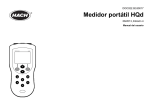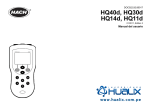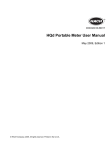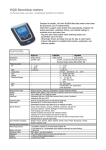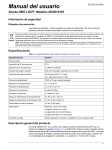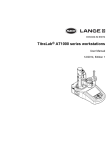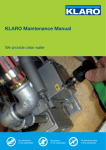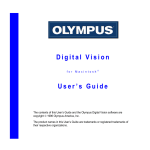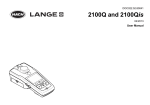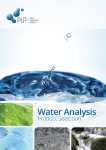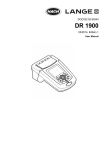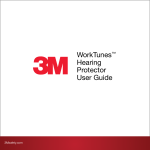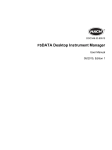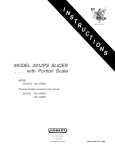Download HQd Portable Meter User Manual
Transcript
DOC022.53.80017 HQd Portable Meter 06/2013, Edition 4 User Manual Table of Contents Specifications ..................................................................................................................................................................................5 General information .....................................................................................................................................................................5 Safety information ..............................................................................................................................................................................5 Use of hazard information ..................................................................................................................................................................5 Precautionary labels ..........................................................................................................................................................................6 Product overview ...............................................................................................................................................................................6 Product components ..........................................................................................................................................................................6 Installation .........................................................................................................................................................................................7 Install the batteries .............................................................................................................................................................................7 Connect to AC power .........................................................................................................................................................................8 User interface and navigation ...............................................................................................................................................9 User interface .....................................................................................................................................................................................9 Display description .............................................................................................................................................................................9 Navigation ........................................................................................................................................................................................11 Startup ...............................................................................................................................................................................................11 Turn the meter on and off ................................................................................................................................................................11 Change the language .......................................................................................................................................................................11 Change the date and time ................................................................................................................................................................12 Connect a probe ..............................................................................................................................................................................12 Standard operation ....................................................................................................................................................................12 About calibration ..............................................................................................................................................................................12 About sample measurements ..........................................................................................................................................................13 About check standards ....................................................................................................................................................................13 Use a sample ID ..............................................................................................................................................................................13 Use an operator ID ...........................................................................................................................................................................13 Data management .......................................................................................................................................................................13 About stored data .............................................................................................................................................................................13 View stored data ..............................................................................................................................................................................14 View stored probe data .............................................................................................................................................................14 1 Table of Contents Print stored data ...............................................................................................................................................................................14 Change the report options ........................................................................................................................................................15 Send data to a USB storage device .................................................................................................................................................15 Open data files on a PC ...................................................................................................................................................................16 Data file description .........................................................................................................................................................................16 Remove column headers .................................................................................................................................................................18 Send data directly to a computer .....................................................................................................................................................18 Advanced operation ..................................................................................................................................................................18 Security options ...............................................................................................................................................................................18 Turn Security Options on ..........................................................................................................................................................18 Full access options menu .........................................................................................................................................................19 Restricted operator access options menu ................................................................................................................................19 Set the display options .....................................................................................................................................................................20 Set the sound options ......................................................................................................................................................................20 Set the probe calibration reminder ............................................................................................................................................21 Change the temperature units .........................................................................................................................................................21 Set the measurement mode .............................................................................................................................................................21 Set auto measurement intervals ...............................................................................................................................................21 Start interval measurements .....................................................................................................................................................21 Prevent data log overflow in interval mode ...............................................................................................................................22 View instrument information .............................................................................................................................................................22 Update the meter software ...............................................................................................................................................................22 Download software updates .....................................................................................................................................................23 Transfer method settings .................................................................................................................................................................23 Bi-directional Communication between the meter and a PC ...........................................................................................................23 About meter control ..................................................................................................................................................................23 About meter configuration .........................................................................................................................................................24 Maintenance ...................................................................................................................................................................................24 Clean the meter ...............................................................................................................................................................................24 Replace the batteries .......................................................................................................................................................................24 Troubleshooting ..........................................................................................................................................................................25 2 Table of Contents Replacement parts and accessories ...............................................................................................................................26 Examples of printed reports ................................................................................................................................................. 28 Index ....................................................................................................................................................................................................33 3 Table of Contents 4 Specifications Specification Details Specifications are subject to change without notice. Connections Integrated USB type A (for USB flash memory device, printer, keyboard) and Integrated USB type B (for PC) Specification Details Dimensions 19.7 x 9.5 cm (7.75 x 3.75 in.) Temperature correction Off, automatic and manual (parameter dependent) Weight 335 g (0.75 lb) without batteries; 430 g (0.95 lb) with four AA alkaline batteries Measurement display lock Continuous measurement, Interval or Press to Read mode. Averaging function for LDO probes. Meter enclosure IP67, waterproof to 1 meter for 30 minutes Keyboard Battery enclosure Water resistant to 0.6 m (2 ft) for 15 seconds External PC keyboard connector via USB/DC adapter Power requirements (internal) AA Alkaline or rechargeable Nickel Metal Hydride (NiMH) batteries (4); battery life: up to 200 hours Power requirements (external) Class II, external power adapter: 100–240 VAC, 50/60 Hz input; 4.5 to 7.5 VDC (7 VA) output Meter protection class Class I Storage temperature –20 to +60 °C (–4 to +140 °F) Operating temperature 0 to +60 °C (32 to 140 °F) Operating humidity 90% (non-condensing) 5-pin input connector M12 connector for IntelliCAL™ probes 8-pin input connector The 8-pin connector enables USB and external AC power connectivity USB/DC adapter Peripheral and host Data memory (internal) 500 results Data storage Automatic in Press to Read mode and Interval Mode. Manual in Continuous Read Mode. Data export USB connection to PC or USB storage device (limited to the storage device capacity). Transfer entire data log or as readings are taken. General information Revised editions are found on the manufacturer’s website. Safety information NOTICE The manufacturer is not responsible for any damages due to misapplication or misuse of this product including, without limitation, direct, incidental and consequential damages, and disclaims such damages to the full extent permitted under applicable law. The user is solely responsible to identify critical application risks and install appropriate mechanisms to protect processes during a possible equipment malfunction. Please read this entire manual before unpacking, setting up or operating this equipment. Pay attention to all danger and caution statements. Failure to do so could result in serious injury to the operator or damage to the equipment. Make sure that the protection provided by this equipment is not impaired. Do not use or install this equipment in any manner other than that specified in this manual. Use of hazard information DANGER Indicates a potentially or imminently hazardous situation which, if not avoided, will result in death or serious injury. English 5 WARNING Indicates a potentially or imminently hazardous situation which, if not avoided, could result in death or serious injury. CAUTION Indicates a potentially hazardous situation that may result in minor or moderate injury. NOTICE Indicates a situation which, if not avoided, may cause damage to the instrument. Information that requires special emphasis. Precautionary labels Read all labels and tags attached to the instrument. Personal injury or damage to the instrument could occur if not observed. A symbol on the instrument is referenced in the manual with a precautionary statement. This symbol, if noted on the instrument, references the instruction manual for operation and/or safety information. This symbol indicates that the marked item can be hot and should not be touched without care. Measurement data can be stored and transferred to a printer, PC or USB storage device. The HQd series meters are available in 4 models: • • • • HQ11d—pH/mV/ORP HQ14d—conductivity, salinity, total dissolved solids (TDS), resistivity HQ30d—all IntelliCAL probes, 1 probe connector HQ40d—all IntelliCAL probes, 2 probe connectors Features common to all models: • • • • • • • • • • Automatic probe and parameter recognition Instrument guided calibration procedures Calibration data stored in the probe Probe specific method settings for regulatory compliance and Good Laboratory Practice (GLP) Security Options Real-time data logging via USB connection USB connectivity to PC/printer/USB storage device/keyboard Bi-directional communication with PC-based systems via a virtual serial port connection Sample ID and Operator ID for data traceability Adjustable automatic shut-off Product components Electrical equipment marked with this symbol may not be disposed of in European public disposal systems after 12 August of 2005. In conformity with European local and national regulations (EU Directive 2002/96/EC), European electrical equipment users must now return old or end-of-life equipment to the Producer for disposal at no charge to the user. Note: For return for recycling, please contact the equipment producer or supplier for instructions on how to return end-of-life equipment, producer-supplied electrical accessories, and all auxiliary items for proper disposal. Product overview The HQd series portable meters are used with digital IntelliCAL™ probes to measure various parameters in water. The meter automatically recognizes the type of probe that is connected to the meter. 6 English Refer to Figure 1 and Figure 2 to make sure that all components have been received. If any items are missing or damaged, contact the manufacturer or a sales representative immediately. Figure 1 Meter components (HQ40d model) Installation CAUTION Multiple hazards. Only qualified personnel must conduct the tasks described in this section of the document. Install the batteries WARNING Explosion hazard. Incorrect battery installation can cause the release of explosive gases. Be sure that the batteries are of the same approved chemical type and are inserted in the correct orientation. Do not mix new and used batteries. NOTICE The battery compartment is not waterproof. If the battery compartment becomes wet, remove and dry the batteries and dry the interior of the compartment. Check the battery contacts for corrosion and clean them if necessary. 1 Meter 4 AC-DC power supply 2 AA batteries (pk/4) 5 USB/DC adapter 3 AC power cord Figure 2 Meter components (HQ11d, HQ14d and HQ30d models) NOTICE When using nickel metal hydride (NiMH) batteries, the battery icon will not indicate a full charge after freshly charged batteries have been inserted (NiMH batteries are 1.2 V versus 1.5 V for alkaline batteries). Even though the icon does not indicate complete charge, 2300 mAH NiMH batteries will achieve 90% of instrument operation lifetime (before recharge) versus new alkaline batteries. NOTICE To avoid potential damage to the meter from battery leakage, remove the meter batteries prior to extended periods of non-use. The meter can be powered with AA alkaline or rechargeable NiMH batteries. To conserve battery life, the meter will power off after 5 minutes of inactivity. This time can be changed in the Display Options menu. For battery installation refer to Figure 3. 1 Meter 2 AA batteries (pk/4) English 7 1. Pull the release tab on the battery cover and the remove the cover. 2. Install 4 AA alkaline or 4 AA nickel metal hydride (NiMH) batteries. Make sure that the batteries are installed in the correct polarity. 3. Replace the battery cover. Connect to AC power DANGER Electrocution Hazard. AC power outlets in wet or potentially wet locations MUST ALWAYS be provided with a Ground Fault Circuit Interrupting (GFCI/GFI) circuit breaker. The AC-DC power adapter for this product is not sealed and must not be used on wet benches or in wet locations without GFCI protection. Figure 3 Battery installation The meter can be powered by AC power with an AC power adapter kit. The kit includes an AC-DC power supply, USB/DC adapter and AC power cord. 1. 2. 3. 4. 5. 6. 1 Batteries 8 English 2 Release tab 3 Battery cover Turn the meter off. Plug the AC power cord into the AC-DC power supply (Figure 4). Connect the AC-DC power supply to the USB/DC adapter. Connect the USB/DC adapter to the meter. Plug the AC power cord into an AC receptacle. Turn the meter on. User interface and navigation Figure 4 AC power connection User interface Figure 5 Keypad description 1 USB storage device/printer/Qwerty keyboard connection (USB peripheral) 4 AC-DC power supply 2 Personal computer connection (USB host) 5 AC power cord 3 USB/DC adapter 1 ON/OFF: turn on or turn off the meter 6 UP and DOWN key: scroll through menus, enter numbers and letters or change the reading screen view 2 OPERATOR ID: associate data with an individual 7 GREEN/RIGHT key: reads, selects, confirms or stores data 3 BACKLIGHT: illuminate the display screen 8 DATA LOG: recall or transfer stored data 4 SAMPLE ID: associate data with a sample location 9 METER OPTIONS: change settings, run check standards, view meter information 5 BLUE/LEFT key: calibrates, cancels or exits the current menu Display description Measurement screen The meter display shows the concentration, units, temperature, calibration status, operator ID, sample ID, date and time (Figure 6). English 9 Figure 6 Single screen display Figure 7 Single-screen display—big-screen mode 1 Calibration status indicator 9 Time 2 Main measurement value and unit 10 Date 3 IntelliCAL probe type and port indicator 11 Read (OK, Select) 4 Battery status 12 Display size icon 5 Power source 13 Calibrate (Cancel, Exit) 6 Sample temperature (ºC or ºF) 14 Sample and operator identification 7 Secondary measurement unit 15 Stability or display lock indicator 8 Tertiary units (for some probes) Big-screen mode The font size of the sample reading can be increased or decreased with the key (Figure 7). Note: When two probes are connected, push and hold the key to select the big-screen mode. The big-screen mode can also be selected in the Display Options menu (Refer to Set the display options on page 20). 10 English 1 Calibration status indicator 5 Main measurement unit 2 IntelliCAL probe type and port indicator 6 Display size icon 3 Power source or battery status 7 Sample temperature (ºC or ºF) 4 Main measurement value 8 Stability or display lock indicator Dual-screen mode (HQ40d model only) When two probes are connected to the HQ40d meter, the display can show the reading from both probes simultaneously or show just one probe (Figure 8). Note: For probe calibration, change the screen mode to the single screen mode. To change the screen mode to single or dual screen, use the and keys. In dual screen mode, the key will select the probe on the left and the key will select the probe on the right. Startup Figure 8 Dual-screen display Turn the meter on and off Push the key to turn on or turn off the meter. If the meter does not turn on, make sure that the batteries are properly installed or that the AC power supply is properly connected to an electrical outlet. Change the language The display language is selected when the meter is powered on for the first time. The language can also be changed from the Meter Options menu. Access to the language menu can be restricted with the Security Options. Refer to Security options on page 18. 1 Probe that is connected to port on left 3 Measurement information for probe on left 2 Probe that is connected to port on right 4 Measurement information for probe on right 1. Push the key and select Language. 2. Select a language from the list. Note: While turning the meter on, the language can also be changed when the power key is pushed and held. Navigation and The meter contains menus to change various options. Use the keys to highlight different options. Push the GREEN/RIGHT key to select an option. There are two ways to change options: 1. Select an option from a list: Use the and keys to select an option. If check boxes are shown, more than one option can be selected. Push the BLUE/LEFT key under Select. Note: To deselect check boxes, push the BLUE/LEFT key under Deselect. 2. Enter an option value using the arrow keys: Push the and keys to enter or change a value. 3. Push the GREEN/RIGHT key to advance to the next space. 4. Push the GREEN/RIGHT key under OK to accept the value. English 11 Change the date and time Figure 9 Probe connection The date and time can be changed from the Date & Time menu. 1. Push the key and select Date & Time. 2. Update the time and date information: Option Description Format Select one of the formats below for the date and time. Use the and keys to select from the format options. dd-mm-yyyy 24h dd-mm-yyyy 12h mm/dd/yyyy 24h mm/dd/yyyy 12h dd-mmm-yyyy 24h dd-mmm-yyyy 12h yyyy-mm-dd 24h yyyy-mm-dd 12h Date Use the and keys to enter the current date. Time Use the and keys to enter the current time. The current date and time will be shown on the display. Connect a probe after the date and time setup, so that the meter is ready to take a measurement. Connect a probe 1. Make sure that the display shows the current time and date. Note: The time stamp for a probe is set when the probe is first connected to the meter. This time stamp makes it possible to record the probe history and record the time when measurements are made. 2. Plug the probe into the meter (Figure 9). 3. Push and turn the locking nut to tighten. 1 Probe connection port (HQ40d only) 2 USB/DC adapter port Standard operation About calibration Each probe uses a different type of calibration solution. Make sure to calibrate the probes frequently to maintain the highest level of accuracy. Note: For step-by-step instructions, refer to the documents that are included with each probe. The calibration icon can indicate that: • the calibration timer has expired 12 English 3 Probe connection port • the LDO sensor cap should be replaced • the calibration is out of range • the calibration results are outside acceptance criteria settings About sample measurements Each probe has specific preparation steps and procedures for taking sample measurements. For step-by-step instructions, refer to the documents that are included with the probe. About check standards Run Check Standards verifies equipment accuracy by measuring a solution of a known value. The meter will indicate if the Check Standard is passed or failed. If the Check Standard fails, the calibration icon shown until the probe is calibrated. The meter can be set to automatically show a reminder for check standard measurement at a specified interval with a specified acceptance criteria. The reminder, value of the check standard, and acceptance criteria can be changed. For step-by-step instructions, refer to the documents that are included with the probe. The operator ID tag associates measurements with an individual operator. All stored data will include the operator ID. 1. Push the key. 2. Select, create or delete an operator ID: Option Description Current ID Select an ID from a list. The current ID will be associated with sample data until a different ID is selected. Create a New Operator ID Enter a name for a new operator ID (maximum 10 names can be entered). Delete Operator ID Delete an existing operator ID. Data management About stored data The following types of data are stored in the data log: Use a sample ID The sample ID tag is used to associate measurements with a particular sample location. If assigned, stored data will include the sample ID. 1. Push the key. 2. Select, create or delete a sample ID: Option Description Current ID Select an ID from a list. The current ID will be associated with sample data until a different ID is selected. Create a New Sample Enter a name for a new sample ID. ID Delete Sample ID Use an operator ID Delete an existing sample ID. • Sample measurements: stored automatically each time a sample is measured in the Press to Read or Interval Mode. When the continuous measurement mode is used, data is stored only when Store is selected. • Calibrations: stored only when Store is selected at the end of a calibration. Calibration data is also stored in the IntelliCAL (R) probe. • Check standard measurements: stored automatically each time a check standard is measured (in the Press to Read or Interval Mode). When the data log becomes full (500 data points), the oldest data point is deleted when a new data point is added. The entire data log can be deleted to remove data that has already been sent to a printer or PC key > Delete Data Log). To prevent deletion of the data log by a ( user, use the Security Options menu. English 13 View stored data Print stored data The data log contains sample, calibration and check standard data. The most recent data point in the data log is tagged as Data Point 001. The meter must connect to AC power to start the USB connection. Make sure that the connection to AC power is made before the meter is powered on. All data can be sent to a printer. The PD-24 Citizen Printer is compatible with the HQd meters and is FCC Part 15B, Class B compliant with the HQ meters. Other printers may not be compatible. Compatible printers should support a minimum of 72 columns of data, be capable of printing up to 500 continuous data-stream events in 1, 2 and 3 lines of text and fully support code page 437 and code page 850. 1. Push the key. 2. Select View Data Log to view the stored data. The most recent data point is shown. The top of the screen shows whether the data is from a sample reading, a calibration or a check standard. Push the key to view the next most recent data point. Option Description Reading Log Reading Log—shows sample measurements including the time, date, operator and sample ID. Select Details to view the associated calibration data. Calibration Log Calibration Log—shows calibration data. Select Details to view additional information about the calibration. Check Standard Log Check Standard Log—shows check standard measurements. Select Details to view the calibration data that was associated with the measurement. View stored probe data Make sure that a probe is connected to the meter. If two probes are connected, select the appropriate probe when prompted. 1. To view the calibration data that is stored in a probe, push the key and select View Probe Data. The current calibration and calibration history for the probe can be viewed. Option Description View Current Calibration The current calibration information shows the calibration details for the most recent calibration. If the probe has not been calibrated by the user, the factory calibration data is shown. View Calibration History The calibration history shows a list of the times when the probe was calibrated. Select a date and time to view a summary of the calibration data. 14 English 1. Turn off the meter. Make sure that the meter is connected to AC power. Refer to Connect to AC power on page 8. 2. Connect the printer to the meter with a USB cable type A. Refer to Figure 10. 3. Turn on the meter. 4. Push the key. 5. Select Send Data Log. Wait for the display to show “Transfer Complete” and wait for the printer to stop printing. Disconnect the printer. Figure 10 Connection to the printer Change the report options Printed reports for sample data can contain 1, 2 or 3 lines of information. Refer to Examples of printed reports on page 28 for further information. 1. Push the key. Select Report Options. 2. Select Report Type and select one of the options. Option Description Basic report One line of data. Advanced report Two lines of data. The first line contains the same information as in the basic report. Total report Three lines of data. The first two lines contain the same information as in the advanced report. Send data to a USB storage device NOTICE The transfer of a large number of data points will take some time. DO NOT disconnect the USB storage device until the transfer is complete. Data can be transferred to a USB storage device for storage or transfer to a computer. 1 Meter 7 USB cable 2 AC-DC power supply 8 USB/DC adapter 3 AC power cord 9 Port for probe connection 4 AC power outlet 10 Port for USB/DC adapter 5 Power supply for printer (optional) 11 Port for probe connection 6 Citizen Printer, FCC Part 15B, Class B compliant 1. Turn off the meter. Make sure that the meter is connected to AC power. 2. Plug the USB storage device into the meter before the meter is powered on. 3. Turn on the meter. 4. Push the key. 5. Select Send Data Log. Wait for the display to show “Transfer Complete” and for any lights on the USB storage device to stop flashing. Then remove the USB device. Note: If the data transfer is slow, reformat the USB storage device to use the file allocation table (FAT) format for the next use. English 15 Open data files on a PC Data that has been downloaded to a USB storage device can be transferred to a computer. The data is sent in a text (.txt) file format. 1. Plug the USB storage device into the computer. 2. Find the data file. The file will have the following format: “Meter Serial Number-Data File Type-Date Time”. Example: 9999NN000000SENDDATA-0603131624.TXT 3. Save the data file to a location on the computer. 4. Open a spreadsheet program such as Microsoft® Excel® spreadsheet software. 5. Open the data file from the spreadsheet program. Select the delimited option with comma as the delimiter. The data will be shown in the spreadsheet program. Note: If an application is used that is not compatible with column headings, the headings can be omitted. Refer to Remove column headers on page 18. Data file description Data that is saved to a USB storage device and then opened in a spreadsheet application will have multiple columns of data. A description for each of the columns is shown in Table 1. Table 1 Spreadsheet column descriptions Table 1 Spreadsheet column descriptions (continued) Column header name Data description and example values Probe Model Model number of probe, for example pHC101, CDC401, LDO101 Probe SN Probe serial number If two probes are connected to the HQ40d meter, the serial number shows “<“ or “>” to identify the port (left or right) the probe was connected to during the reading. Method name User-defined name of the probe settings that were used for the reading. Sample ID Sample ID that was used when the data was recorded. Shows "Sample ID" if the default sample ID is used. Primary Reading Value Measured value. Shows “—" if the value was out of range. Primary Reading Units Measurement units, for example pH or µS/cm Supp Reading 1 First supplemental reading (example: temperature), if applicable Supp Units 1 Units for first supplemental reading, if applicable. Supp Reading 2 Second supplemental reading (example: “mV” for pH), if applicable Column header name Data description and example values Type Type of data: RD = Reading; CL = Calibration; CK = Check Standard; CH = Calibration History; IC = Current Calibration Supp Units 2 Units for second supplemental reading, if applicable Supp Reading 3 Third supplemental reading, if applicable Type Parameter: LDO, pH, CD (conductivity), ORP, ISE Supp Units 3 Units for third supplemental reading, if applicable. Reading Setting 1–4 Any settings that affect the reading, for example “NaCl/Non-Linear” Parameter Date Date of reading: stored in user-defined date format Time Time of reading: stored in user-defined format Operator ID Operator ID that was used when the data was recorded. Shows “- - -” if no operator ID is used. 16 English Any settings that affect Reading Message 1–4 Any message that was shown the reading, for example during the measurement, for example “Out of limits”. “NaCl/Non-Linear” Table 1 Spreadsheet column descriptions (continued) Table 1 Spreadsheet column descriptions (continued) Column header name Data description and example values Column header name Data description and example values Check Std Value Value of the check standard that was used to verify accuracy, for example: 7.00 pH–25 ºC (pH, tempcompensated); 7.01 pH (pH, custom) Cal Number of Std’s Number of standards used during calibration, for example 5. May be blank depending on record type, parameter type, and method settings. Check standard units, for example μS/cm. Cal Std 1 Known value of the first calibration standard Note: pH is not displayed here as it is included in the previous column. Cal Std 1 Units Units of the first calibration standard Bar-graph showing the measurement in relation to the acceptance limits. Example: “6.901 <—|—> 7.101”. Cal Std 1 Primary Value Measured value of the first calibration standard Status of the check standard reading. Example: “Reading within limits”, “Reading outside limits” Cal Std 1 Primary Units Associated units for the calibration measurement Cal Std 1 Supp Value Value of supplemental measurement, for example temperature = current Status of the calibration that is in use. calibration is valid; = calibration has expired. Cal Std 2–7 Known value of additional calibration standards, if used Cal Date Date of calibration reading: stored in user-defined date format Cal Std 2–7 Units Units of additional calibration standards, if used Cal Time Time of calibration reading: stored in user-defined time format Cal Std 2–7 Primary Value Measured values of additional calibration standards, if used Cal Operator ID The operator ID specified when the probe was calibrated. Shows “- - -” if undefined. Cal Std 2–7 Primary Units Associated units for additional calibration measurements, if used Cal Std 2–7 Supp Value Cal Slope Name Slope (pH or LDO) or cell constant (conductivity) Value of supplemental measurement, for example temperature Cal Slope The slope value for the calibration Cal Std Supp Units Cal Slope Aux Used by pH to give the percent of nominal slope Units applicable to all secondary calibration readings. Example: “ºC” or “ºF” for temperature Cal Slope Units Units of the calibration slope. Example: “mV/pH” for pH Cal Message 1–4 Any messages about the calibration Date/Time POSIX Cal Offset Calibration offset value Date and time of reading stored in POSIX format (number of seconds from January 1, 1970) Example: 1149234913 Cal Offset Units Calibration offset units. Example: “mV” for pH. Cal Date/Time POSIX Cal r² Calibration correlation coefficient without a unit (may be blank) Date and time of calibration stored in POSIX format (number of seconds from January 1, 1970). Example: 1111320348 Meter SN Meter serial number used to take the measurement Check Std Units Check Std Graph Check Std Status Calibration Status English 17 Remove column headers Advanced operation When transferred data is viewed in a spreadsheet program, the first row of data contains headings to identify the type of data in each column. If an application or post-processing method is used that is incompatible with the headers, the column headers can be omitted. Security options 1. Push the key. 2. Select Column Headers. 3. Set the column headers to off. Send data directly to a computer Data can be transferred from any HQd series meter directly to a computer when the HQ40d PC Application is installed. The data can be sent in real time during data collection, or the entire data log can be transferred. To download the most current version of the software, refer to the applicable product page on the manufacturer's website. 1. Install the HQ40d PC Application on the computer. 2. Turn off the meter. Make sure that the meter is connected to AC power. 3. Connect the PC to the meter with a USB type B cable. 4. Turn on the meter. 5. Open the HQ40d PC Application on the computer. Click on the green triangle in the menu bar to start a connection. 6. Collect the data in real time or transfer the data from the data log: • Real time—when a data point is stored in the meter, the result is sent simultaneously to the PC Application (refer to Set the measurement mode on page 21). key and select Send Data Log. Wait for • Data log—push the the display to show “Transfer Complete.” The data is sent as a comma separated values (.csv) file. The data is shown in the HQ40d PC Application window. 18 English The Security Options menu is used to protect the meter setup and method settings from unwanted changes. This menu is available in the Full Access Options menu. The Setup Measurement Mode, Date and Time, Temperature Units, Language, Probe settings, Delete data log and Security Options screens are disabled in the Operator Access Options menu. All menu options are enabled in the Full Access Options menu. Note: The Full Access Options menu is shown when the key is pushed when Security Options is OFF, whether or not a password has been set. When the meter is powered on for the first time and Security Options is selected, the display prompts the user to set a password. Until the meter is shut off, pushing the key will still display the Full Access Options menu, even after Security Options is turned on and a password has been set. After the meter is shut off and powered on again with Security Options on, the Operator Access Options menu is displayed until a valid password is entered. Store the password in a safe and accessible place. If the specified password is forgotten and Security Options is turned on, the operator is locked out of the restricted menus. Contact technical support if the password is lost. Turn Security Options on The Security Options and the Set Password options are used together to prevent access to restricted menus. 1. Push the key and select Security Options. 2. Change the settings as needed to allow or prevent menu access. Option Description Security Options When Security Options is on, and a password has been specified, the password is required to enable the Full Access Options menu. If the meter is turned off while Security Options is on, the password is required to enable the Full Access Options menu again when the meter is turned on. Set Password Set a password that must be entered to enable the Full Access Options menu. The requirement for password entry is controlled by setting Security Options on or off. Table 2 Full Access Options (continued) Option Security options Display options Description (Probe model) settings Settings such as measurement options, calibration options, check standard options, units and resolution. Refer to the probe documentation for more information. Contrast Auto shutoff Backlight Mode Sounds Key press Stability alert Calibration reminder Date and time Format Date Table 2 Full Access Options Option ON or OFF Set password Full access options menu The Full Access Options menu is displayed when Security Options is OFF or when Security Options is ON and a valid password is entered (Table 2). These options do not need to be changed if the factory default settings are used. Description Time Temperature units Set temperature units Language Select language Note: A probe must be connected to the meter. Restricted operator access options menu Run check standard Measure standard solution (available for pH, conductivity, ORP and ISE probes) Measurement mode Press to Read The Operator Access Options menu is shown at meter startup when Security Options is ON (Table 3). When a valid password is entered, the menu changes to Full Access Options. Interval: Duration and Interval Continuous Instrument information Probe information Meter information English 19 Table 3 Operator access options Option Description (Probe model) settings Only methods (if methods exist) can be selected. Refer to the probe documentation. Option Description Autoshutoff To maximize battery life, set a time period after which the meter will automatically power off if no key is pushed (1, 2, 5, 10, 30 min, 1 h, 2 h or never). Auto-shutoff is not active when the meter is connected to AC power or in the Interval Reading Mode. Backlight The display backlight is turned off when the key is pushed. Is it possible to set a time period after which the backlight will automatically power off if no key is pushed. Mode Select Detailed or Big screen size. Detailed will show more information with smaller numbers and text. Big will show less information with larger numbers and text. Note: The screen size can also be selected from the measure mode (refer to Display description on page 9). Note: A probe must be connected to the meter. Run check standard Measure standard solution (available for pH, conductivity, ORP and ISE probes) Note: A probe must be connected to use this option. Instrument information Probe information Meter information Access password Enter password Display options Contrast Auto shutoff Set the sound options Backlight The meter can make an audible sound when a key is pushed, when stability is reached or when the calibration reminder is due. The meter also makes an audible sound when it begins transferring data to a USB storage device and again when the data transfer is complete. Mode Sounds Key press Stability alert Calibration reminder Set the display options Use Display Options to change the display contrast, battery saving autoshutoff options, the backlight option or the detailed or big reading screen mode. 1. Push the key and select Display Options. 2. Select which display option to change. Option Description Contrast Adjust the contrast of the display. The lightest setting is 0 and the darkest setting is 9. 20 English 1. Push the key and select Sound. 2. Choose which events will produce an audible sound. Multiple items can be selected. Option Description Key Press The meter will make an audible sound whenever a key is pushed. Stability Alert The meter will make an audible sound whenever measurement stability is reached. Cal reminder The meter will make an audible sound when calibration is due. Note: Refer to Set the probe calibration reminder to set the calibration reminder to on or off. Set the probe calibration reminder 3. Select one of the measurement modes. Make sure that a probe is connected to the meter. Option 1. Push the key and select the probe settings. 2. Select Modify Current Settings. 3. Select Calibration Options. 4. Select Calibration Reminder. Press to Read The sample is measured only when the GREEN/RIGHT key under Read is pushed. Data is stored in the data log automatically when the stability criteria are met. Option Description Calibration reminder Reminder repeat: Off, 2 h, 4 h, 8 h, 2 d, 5 d, 7d Expires: Immediately, Reminder + 30 min, Reminder + 1 hr, Reminder + 2 hr, Continue Reading The meter can be set to make an audible sound when calibration is due. Calibration expires after a specified time set by the user. Note: The meter cannot be used to read samples after calibration has expired unless Continue Reading is selected. Change the temperature units To select degrees Celsius or Fahrenheit: 1. Push the key and select Temperature Units. 2. Select the Celsius or Fahrenheit option. Set the measurement mode One of three modes can be used to specify when measurements are taken and how the data is stored. When a data point is stored, the result is sent simultaneously to any device (PC/printer/ USB storage device) that is connected to the meter. 1. Push the key and select Measurement Mode. 2. Select Mode. Description Interval The sample is measured at regular intervals for a specified duration (refer to Set auto measurement intervals on page 21). Data is stored in the data log automatically. Continuous The sample is measured continuously. Data is stored in the data log only when the GREEN/RIGHT key under Store is pushed. Set auto measurement intervals When the measurement mode is set to Interval, the time intervals and duration must be specified. Measurements are stored at the user-defined intervals whether or not stability criteria are met. Note: Use of an external USB storage device or direct printer connection while in Interval Measurement mode prevents data from being over-written in the data log. Data points are over-written on a First In/First Out basis. Refer to Prevent data log overflow in interval mode on page 22. Push the key and select Measurement Mode. Select Mode. Select Interval as the Measurement Mode. Select Duration and select the total time that measurements will be taken for (15 min, 30 min, 1 h, 4 h, 8 h, 24 h, 48 h or no limit). 5. Select Interval and select how often measurements will be taken (every 10 s, 30 s, 1 min, 5 min, 15 min or 30 min). 1. 2. 3. 4. Start interval measurements During interval measurements, the meter goes into a standby state between readings to conserve power. The auto-shutoff option is disabled. Measurements stop when the selected interval duration has passed. The auto-shutoff option then becomes active. English 21 Interval measurements are suspended for calibrations, check standard measurements or when the key is pushed. Interval measurements resume when returning to the measurement screen. 1. From the Main Measurement screen, select Start to begin interval measurements. The screen will show “Recording” and the remaining time of the duration. The sample number automatically advances when each reading is taken. 2. To stop interval measurements, select Stop. 3. To repeat the interval measurement after it has been stopped or completed, select Start. View instrument information The instrument information menu shows specific information such as the serial number for the meter or IntelliCAL (R) probe(s). 1. Push the key and select Instrument Information. 2. Select (Probe model) Information or Meter Information. Option Description Probe information The Probe Information screen shows the probe model number, serial number, software version and date of first use. For LDO and LBOD probes, the lot code for the sensor cap and the remaining time before sensor cap replacement is shown. Note: A probe must be connected to the meter. Meter information The Meter Information screen shows the meter model number, serial number, software version and memory information. The amount of memory used and the number of available user method settings, operator IDs and sample IDs is shown. Prevent data log overflow in interval mode When measurements are taken at specified intervals (Table 4), each result is automatically stored. The meter can store up to 500 data records. When 500 records have been stored, data is replaced on a firstin, first-out basis. To prevent loss of data, connect the meter to a PC/printer/USB storage device. Note: Stop interval measurements before changes are made to a method or to meter settings. Table 4 Recommended interval/duration pairs Update the meter software A USB storage device that contains software update files is used to update the meter software. Interval Duration 10 seconds 1 hour 30 seconds 4 hours 1 minute 8 hours NOTICE 5 minutes 24 hours Do not remove the USB device until the “Update complete” message is shown. The meter can become damaged if the USB device is removed before the update process is complete. Note: When 2 probes are connected to the meter, use the next lowest recommended duration time. For example, for a 30-second interval, set the duration to 1 hour to prevent data log overload with 2 probes. 22 English Note: The meter must be turned off and then on again before the software update will begin. The software update initiates upon meter startup after the USB device is correctly inserted. 1. Save stored data from the data log to a USB storage device or to a PC. Refer to Send data to a USB storage device on page 15 and Send data directly to a computer on page 18. 2. Turn off the meter. 3. Connect the USB/DC adapter, AC-DC power supply and cord (Figure 4 on page 9). 4. Insert the USB storage device that contains the software update files into the USB/DC adapter. 5. Turn on the meter. The update process starts. The display will show “Updating meter to <firmware version>”. After an interval, the display changes to “Updating files, please wait...” In addition, the display will show a rotating flask and emit a periodic audio signal during the update process. Note: A large capacity USB storage device increases the time required for completion of the update process, even if most of the device memory is empty. 6. Wait for the meter to finish the software update. When the update process is complete, the message “Update complete. Remove USB device” is shown. The meter will turn off after the USB device has been removed. 7. Repeat steps 1 through 6 to update the software in other HQd meters as necessary. Download software updates To download the most current version of the software, refer to the applicable product page on the manufacturer's website. 1. Transfer the update files to a USB storage device. 2. Follow the instructions in Update the meter software on page 22 to update the software in the meter. Transfer method settings Probe settings that have been changed by the user for measurements, calibrations or check standards (Meter Options > (Probe Model) Settings > Modify Current Settings) can be copied to a USB storage device. The USB device can then be used to transfer the method settings to other HQd meters that accept the same probes. NOTICE Make sure the USB storage device does not contain HQd meter software update files to prevent unintentional updates. 1. Turn off the meter. 2. Connect the meter to AC power (Figure 4 on page 9). 3. Plug the USB storage device into the USB/DC adapter before the meter is powered on. 4. Turn on the meter. 5. Push the key and select Transfer Methods. If the USB device already contains a method settings file, an option to export or import methods is shown. Select Export Methods. 6. In the Select Methods to Export screen, select one or more methods to copy to the USB device. A check mark is shown next to each selected method. 7. Select OK. The settings are copied to the USB storage device. When complete, the Transfer Summary screen is shown. 8. Connect the AC power and USB device to a meter that will receive the method settings. Turn the meter on. 9. Push the key and select Transfer Methods. If the USB device already contains a method settings file, an option to export or import methods is shown. Select Import Methods. 10. In the Select Methods to Import screen, select one or more methods to transfer to the meter. A check mark is shown next to each selected method. 11. Select OK. The user method settings are transferred from the USB storage device to the meter. When complete, the Transfer Summary screen is shown. Select details to view additional information about the transfer. 12. Disconnect the USB storage device from the meter. Bi-directional Communication between the meter and a PC For measurement automation the meter can be used to implement a command set for meter remote control or automated data transfer. The command set can be used to perform minimal configuration and to control the meter. To set up the meter for communication and control, refer to About meter configuration on page 24. For additional information and the command set contact Technical Support. About meter control The virtual serial connection can be used to control meter functions from a PC. For example, the functions include starting a measurement cycle, English 23 turning off the meter and sending the entire measurement (including calibrations) to the PC or other information management system. About meter configuration To use the meter communication and control from the PC, an INF file must be installed. 1. The meter software must be version 2.0.0.710 or higher. To download the most current version of the software, refer to the applicable product page on the manufacturer's website. 2. Open the Zip file. 3. Copy the INF file from the software upgrade package to a convenient location on the PC. 17. Click Finish to complete the Found New Hardware Wizard for: HQd Meter - Virtual Serial Port. 18. To make sure that the installation succeeded, go to Computer Management>Device Manager>Ports. The new installed port is listed as HQd Meter - Virtual Serial Port (COM#). 19. The meter is now ready for communication with PC-based systems using the Virtual Serial port. A program interface must be developed by the user for the command set used to control the meter functions from the PC. Contact Technical Support for more information and command set documentation. Maintenance Note: The INF file must be installed to use the meter manual control from a PC. 4. Turn on the meter. 5. Push the key and select Instrument Information. 6. Select USB Device Type and then select Virtual Serial to use the virtual serial port on the meter. 7. Push OK. The meter will automatically restart to complete the setting change. 8. Connect the meter with the USB cable to the PC and turn on the meter. Windows XP starts the "Found New Hardware Wizard". 9. Select "No, not at this time" to the query "Can Windows connect to Windows Update to search for software?" 10. Click Next. The next wizard screen will prompt. 11. Select "Install from a list or specific location (Advanced)" to the query "What do you want the wizard to do?" 12. Click Next. The next wizard screen will prompt. 13. Select the option "Search for the best driver in these locations." 14. Uncheck the "Search removable media (floppy, CD-ROM)" option and select the "Include this location in the search:" and click the "Browse" button. 15. Select the INF folder or location and click OK. 16. Click Next. The new software will be installed. 24 English CAUTION Multiple hazards. Only qualified personnel must conduct the tasks described in this section of the document. Clean the meter The meter is designed to be maintenance-free and does not require regular cleaning for normal operation. Exterior surfaces of the meter may be cleaned as necessary. 1. Wipe the surface of the meter with a damp cloth. 2. Use a cotton-tipped applicator to clean or dry the connectors. Replace the batteries WARNING Explosion hazard. Incorrect battery installation can cause the release of explosive gases. Be sure that the batteries are of the same approved chemical type and are inserted in the correct orientation. Do not mix new and used batteries. For battery replacement, refer to Figure 11. Make sure that the cover is tightly closed to maintain the IP67 enclosure rating. 1. Pull the release tab on the battery cover and the remove the cover. 2. Remove the batteries. 3. Install 4 AA alkaline or 4 AA nickel metal hydride (NiMH) batteries. Make sure that the batteries are installed in the correct polarity. 4. Replace the battery cover. Error/Warning Connect a Probe Figure 11 Battery replacement Description Probe disconnected or connected improperly Tighten the locking nut on the probe connector. Software not updated to most current version To download the most current version of the software, refer to the applicable product page on the manufacturer's website. Problem with probe Connect a different IntelliCAL probe to verify if problem is with probe or meter Probe Not Supported Probe disconnected or connected improperly Bootloader X.X.XX.XX error 1 Batteries 2 Release tab 3 Battery cover Solution Disconnect the probe and then connect the probe again Tighten the locking nut on the probe connector. Disconnect the probe and then connect the probe again. Software not updated to most current version To download the most current version of the software, refer to the applicable product page on the manufacturer's website. Problem with probe Connect a different IntelliCAL probe to the meter to verify if problem is with the meter or the probe. HQd meter does not support IntelliCAL probe Contact Technical Support. Software not updated to most current version. To download the most current version of the software, refer to the applicable product page on the manufacturer's website. Troubleshooting Refer to the following table for common problem messages or symptoms, possible causes and corrective actions. English 25 Error/Warning 0 days remaining message (For LDO and LBOD only) Description LDO or LBOD sensor cap used for 365 days Replace the LDO or LBOD sensor cap and iButton®. There are 0 days remaining in the life of the LDO sensor cap. Replace the LDO sensor cap. Calibration will be allowed. However, the calibration icon and question mark will appear on the measurement screen even if the calibration has passed. Meter set to incorrect date and time Meter not configured 26 English Solution 1. Disconnect the probe from the meter. 2. Remove the meter batteries. 3. Install the meter batteries properly. Follow the polarity makings. 4. Set correct date and time in the meter. 5. Connect the probe and verify that message has been removed. Software not updated to most current version To download the most current version of the software, refer to the applicable product page on the manufacturer's website. Software error(s) If the meter starts up correctly, back up the Data Log and Method files. To download the most current version of the software, refer to the applicable product page on the manufacturer's website. Error/Warning Meter will not power on or powers on intermittently Description Batteries are not installed correctly Solution Examine battery orientation to make sure the batteries follow the polarity markings. Test again. Clean the battery terminals, then install new batteries. Connect AC power adapter and test again. Software not updated to most current version To download the most current version of the software, refer to the applicable product page on the manufacturer's website. Damaged meter Contact Technical Support. Unable to access Full Access Options screen Correct password has not been entered Contact Technical Support. Unable to access Full or Operator Access Options screen Software not updated to most current version To download the most current version of the software, refer to the applicable product page on the manufacturer's website. Replacement parts and accessories Note: Product and Article numbers may vary for some selling regions. Contact the appropriate distributor or refer to the company website for contact information. Replacement parts Description Item no. AC Power/USB Adapter Kit, 115 VAC 5826300 AC Power/USB Adapter Kit, 230 VAC 5834100 Batteries, Alkaline AA 1938004 Battery cover 9245500 Battery Contact, dual fixed 5188400 Replacement parts (continued) Description Item no. Battery Contact, dual spring 5188800 Cable, USB 6 ft (1.8 m), Type A male, Type B male 5924000 Field Kit (includes Protective Glove Kit for meter and five 120-mL sample cups) 5825800 Field Case for 2 probes with up to 5 m cables (10 m total). Includes empty case, insert for meter and probe storage, 4 containers for sample collection. 8505500 Field Case for 3 probes with up to 5 m cables (15 m total). Includes empty case, insert for meter and probe storage, 4 containers for sample collection. 8505501 Field Case for 2 probes with greater than 5 m cables (30 m total). Includes empty case, insert for meter with protective glove. 8505600 Keyboard (QWERTY), USB type Printer, Citizen PD-24 USB printer, 120–220 VAC LZV582 US: 2960100 EU: 5835900 Printer Paper for Citizen PD-24, thermal, 5/pk 5836000 Probe Clips, color coded (5 colors, 2 clips of each color), 10/pk 5818400 Probe Depth Marker (rugged cables) 5828610 Probe Holder, standard (fits on protective glove) 5829400 Protective Glove Kit for meter 5828700 Universal Probe Stand for standard IntelliCAL Probes 8508850 Meter Stand for Portable HQd meters 4754900 English 27 Examples of printed reports Printed reports contain a report header and all stored data for samples, check standards and calibrations. Report header The first line of a report shows the report header (Figure 12). Figure 12 Report header 1 Meter serial number1 3 Date and time, 24 h (YYMMDDhhmm) 2 Report label 4 File type extension 1 The probe serial number is shown on calibration history and current calibration reports. Data reports Sample data can be printed in a basic, advanced or total report format. • Total report—refer to Figure 13. • Advanced report—refer to Figure 14. • Basic report—refer to Figure 15. 28 English Figure 13 Basic report for sample data—1 line 1 Data type (RD=reading) 6 Units 2 Parameter (pH, LDO, etc.) 7 Sample ID: user-defined; shows “SAMPLE ID” if undefined 3 Time (hh:mm:ss in 24 h or user-defined format) 8 Sample ID counter 4 Date (DD-MM-YY or user-defined format) 9 Operator ID: user-defined; shows “- - -” if undefined 5 Measured value Figure 14 Advanced report for sample data—2 lines 1 Probe model 4 Additional units: shows all additional units associated with the reading. 2 Error message (if applicable) 5 Probe settings: shows the highest-priority setting associated with the reading 3 Probe serial number (a “<“ or “>” on the HQ40d meter indicates the probe position) English 29 Figure 15 Total report for sample data—3 lines 1 Method name for probe settings 4 Calibration slope/ratio/constant 2 Time of calibration, prefaced by “CAL” and displayed as hh:mm in 24 h (or userdefined) format 5 Offset—contents vary depending on type of parameter and user settings. May be blank. 3 Date of calibration (DD-MM-YY or user-defined format) 6 Operator ID: user-defined; shows “- - -” if undefined Check standard reports Check standard data is printed with 1 line of information (Figure 16) Figure 16 Check standard report 1 Report type (ST = check standard) 5 Measured value 2 Report type (ST = check standard) 6 Units 3 Time (hh:mm:ss in 24 h or user-defined format) 7 Check standard status: Pass/Fail based on the acceptance criteria 4 Date (DD-MM-YY or user-defined format) 8 Operator ID: user-defined; shows “- - -” if undefined 30 English Calibration reports Calibration data is printed when the data log is sent to the printer or when probe data is sent to the printer. Calibration data is printed with 2 lines of information (Figure 17). Figure 17 Calibration report 1 Report type (CL = calibration, IC = current calibration) 7 Probe serial number (a “<“ or “>” on the HQ440d meter indicates the probe position) 2 Parameter (pH, LDO, etc.) 8 Calibration slope/ratio/constant 3 Method name for probe settings 9 Offset—contents vary depending on type of parameter and user settings. May be blank. 4 Time of calibration, prefaced by “CAL” and displayed as hh:mm in 24 h (or userdefined) format 10 r²: contents vary depending on type of parameter being read, configuration of specific method and number of calibration standards used. May be blank. 5 Probe model 11 Operator ID: user-defined; shows “- - -” if undefined 6 Date of calibration (DD-MM-YY or user-defined format) The calibration history can be printed from the probe data menu. Refer to Figure 18. English 31 Figure 18 Calibration history report 1 Report type (CH=calibration history) 5 Date of calibration (DD-MM-YY or user-defined format) 2 Parameter (pH, LDO, etc.) 6 Probe serial number (a “<“ or “>” on the HQ40d meter indicates the probe position). 3 Time of calibration, prefaced by “CAL” and displayed as hh:mm in 24 h (or userdefined) format 7 Calibration slope/ratio/constant 4 Probe model 8 Offset—contents vary depending on type of parameter and user settings. May be blank. 32 English Index A AC power connection ............................................................................... 8 auto-shutoff ............................................................................................ 20 B backlight ................................................................................................. 20 Bi-directional Communication ................................................................ 23 big screen mode .............................................................................. 10, 20 C calibration ............................................................................................... 12 dual-screen mode ............................................................................. 10 probe reminder .................................................................................. 21 reminder ............................................................................................ 20 check standards ..................................................................................... 13 contrast, display ..................................................................................... 20 D data file descriptions .............................................................................. 16 data log .................................................................................................. 23 prevent data loss ............................................................................... 22 printing .............................................................................................. 14 transfer data to PC ...................................................................... 18, 24 data log, stored data .............................................................................. 14 date and time changing ............................................................................................ 12 detailed screen mode ............................................................................. 20 display description ................................................................................. 20 dual-screen mode calibration .......................................................................................... 10 I M measurement modes ............................................................................. 21 menu navigation ..................................................................................... 11 modes screen ............................................................................................... 20 O operator ID ............................................................................................. 13 P power ....................................................................................................... 8 printing ................................................................................................... 14 probes connecting ......................................................................................... 12 stored data ........................................................................................ 14 S sample ID ............................................................................................... 13 screen modes .......................................................................................... 9 security options ...................................................................................... 18 restrict menu access ......................................................................... 19 software install PC Application software .......................................................... 18 update meter software ...................................................................... 22 sounds, turn on or off ............................................................................. 20 stored data ....................................................................................... 13, 14 file descriptions ................................................................................. 16 probe ................................................................................................. 14 interval measurements ........................................................................... 21 33 Index T transfer data to PC ........................................................................................... 16, 18 to USB storage device ...................................................................... 15 transfer data to USB device data log ............................................................................................. 23 troubleshooting ...................................................................................... 25 34 U USB storage device file descriptions ................................................................................. 16 transfer data to .................................................................................. 15 HACH COMPANY World Headquarters P.O. Box 389, Loveland, CO 80539-0389 U.S.A. Tel. (970) 669-3050 (800) 227-4224 (U.S.A. only) Fax (970) 669-2932 [email protected] www.hach.com © HACH LANGE GMBH Willstätterstraße 11 D-40549 Düsseldorf, Germany Tel. +49 (0) 2 11 52 88-320 Fax +49 (0) 2 11 52 88-210 [email protected] www.hach-lange.de HACH LANGE Sàrl 6, route de Compois 1222 Vésenaz SWITZERLAND Tel. +41 22 594 6400 Fax +41 22 594 6499 Hach Company/Hach Lange GmbH, 2010, 2013. All rights reserved. Printed in U.S.A.






































